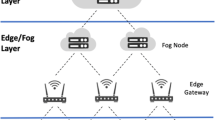Abstract
Internet of Things is the current evolution of the Internet, which is opening tremendous opportunities for a large number of novel applications that promise to revolutionize and improve the quality of human life. For this reason, much attention has been oriented towards this theme from different perspectives. The problem treated by this paper is the necessity of having a mechanism that enables IoT systems to perform with transparency without stops or breaks regardless of the changes that affect the surrounding context. We propose a contextual dynamic reconfiguration process to be applied on the architectural level of IoT systems; the process relies on autonomic computing MAPE-K loop. The originality of our work is the use of architectural styles to make reusable all the architectural evolutions applied on the system.






Similar content being viewed by others
Explore related subjects
Discover the latest articles and news from researchers in related subjects, suggested using machine learning.References
Acosta Padilla FJ, Weis F et al (2014) Towards a model@ runtime middleware for cyber physical systems. In: Proceedings of the 9th workshop on middleware for next generation internet computing, ACM
Al-Fuqaha A, Guizani M et al (2015) Internet of things: a survey on enabling technologies, protocols, and applications. IEEE Commun Surv Tutor 17(4):2347–2376
Ashton K (2009) That ‘internet of things’ thing. RFID J 22(7):97–114
Atzori L, Iera A et al (2010) The internet of things: a survey. Comput Netw 54(15):2787–2805
Azimi I, Rahmani AM et al (2017) Internet of things for remote elderly monitoring: a study from user-centered perspective. J Ambient Intell Humaniz Comput 8(2):273–289
Benghozi P-J, Bureau S et al (2012) Internet of things: what challenges for Europe. Les Editions de la MSH, Paris
Bettini C, Brdiczka O et al (2010) A survey of context modelling and reasoning techniques. Pervasive Mob Comput 6(2):161–180
Blomstedt J (2008) A unified approach to adaptive code selection for modern systems. University of Colorado, Boulder
Brogi A, Cámara J et al (2007) Dynamic contextual adaptation. Electron Notes Theor Comput Sci 175(2):81–95
Coen MH (1998) Design principles for intelligent environments. AAAI/IAAI
Conan D, Rouvoy R et al (2007) Scalable processing of context information with COSMOS. In: IFIP international conference on distributed applications and interoperable systems, Springer
Corradi A, Lodolo E et al (2009) Dynamic reconfiguration of middleware for ubiquitous computing. In: Proceedings of the 3rd international workshop on Adaptive and dependable mobile ubiquitous systems, ACM
Da Xu L, He W et al (2014) Internet of things in industries: a survey. IEEE Trans Ind Inform 10(4):2233–2243
Darwish A, Hassanien AE (2018) Cyber physical systems design, methodology, and integration: the current status and future outlook. J Ambient Intell Humaniz Comput 9(5):1541–1556
Ferry N, Lavirotte S et al (2008) Adaptation Dynamique d’Applications au Contexte en Informatique Ambiante. Rapport Technique, Laboratoire I3S (Universite de Nice Sophia Antipolis/CNRS), numero I3S/RR-2008-20-FR, Sophia Antipolis, France
Floch J, Hallsteinsen S et al (2006) Using architecture models for runtime adaptability. IEEE Softw 23(2):62–70
Garlan D, Siewiorek DP et al (2002) Project aura: Toward distraction-free pervasive computing. IEEE Pervasive Comput 1(2):22–31
Guthikonda RT, Chitta SS et al (2014) Comparative analysis of IoT architectures. TLEN 5710 Capstone, Tech. Rep
Hassan A, Queudet A et al (2016) Evolution style: framework for dynamic evolution of real-time software architecture. In: European conference on software architecture, Springer
Kaasinen E (2003) User needs for location-aware mobile services. Pers Ubiquitous Comput 7(1):70–79
Khan R, Khan SU et al (2012) Future internet: the internet of things architecture, possible applications and key challenges. In: Frontiers of information technology (FIT), 2012 10th international conference on, IEEE
Kirsch Pinheiro M (2006) Adaptation contextuelle et personnalisée de l’information de conscience de groupe au sein des Systèmes d’Information coopératifs. Université Joseph Fourier, Grenoble
Kortuem G, Kawsar F et al (2010) Smart objects as building blocks for the internet of things. IEEE Internet Comput 14(1):44–51
Le Goaer O (2009) Styles d’évolution dans les architectures logicielles, Université de Nantes; Ecole Centrale de Nantes (ECN)(ECN)(ECN)(ECN)
Le Goaer O, Oussalah M et al (2007) Evolution dirigée par les styles. Atelier RIMEL (Rétro-Ingénierie, Maintenance et Evolution des Logiciels)
Marconi A, Pistore M et al (2009) Enabling adaptation of pervasive flows: built-in contextual adaptation. Service-Oriented Computing. Springer, New York, pp 445–454
Musumba GW, Nyongesa HO (2013) Context awareness in mobile computing: a review. Int J Mach Learn Appl 2(1):5
Preuveneers D, Van den Bergh J et al (2004) Towards an extensible context ontology for ambient intelligence. In: European symposium on ambient intelligence, Springer
Rao L, Fan C et al (2015) A self-adapting dynamic service management platform for internet of things. LISS 2013. Springer, New York, pp 783–791
Scholze S, Barata J (2016) Context awareness for flexible manufacturing systems using cyber physical approaches. In: Doctoral conference on computing, electrical and industrial systems, Springer
Su J-M, Tseng S-S et al (2011) A personalized learning content adaptation mechanism to meet diverse user needs in mobile learning environments. User Model User Adapt Interact 21(1):5–49
Talbot V, Benyahia I (2010) Complex application architecture dynamic reconfiguration based on multi-criteria decision making. Int J Software Engineer Appl 1(4):19–37
Whitmore A, Agarwal A et al (2015) The Internet of Things—a survey of topics and trends. Inf Syst Front 17(2):261–274
Wojciechowski M, Xiong J (2008) On context modeling in ambient assisted living. In: Fifth international workshop modeling and reasoning in context (MRC 08), Delft, Niederlande
Wu M, Lu T-J et al (2010) Research on the architecture of Internet of things. In: Advanced computer theory and engineering (ICACTE), 2010 3rd international conference on, IEEE
Author information
Authors and Affiliations
Corresponding author
Additional information
Publisher’s Note
Springer Nature remains neutral with regard to jurisdictional claims in published maps and institutional affiliations.
Rights and permissions
About this article
Cite this article
Hakim, A., Amirat, A. & Oussalah, M.C. Non-intrusive contextual dynamic reconfiguration of ambient intelligent IoT systems. J Ambient Intell Human Comput 11, 1365–1376 (2020). https://doi.org/10.1007/s12652-018-1127-2
Received:
Accepted:
Published:
Issue Date:
DOI: https://doi.org/10.1007/s12652-018-1127-2




